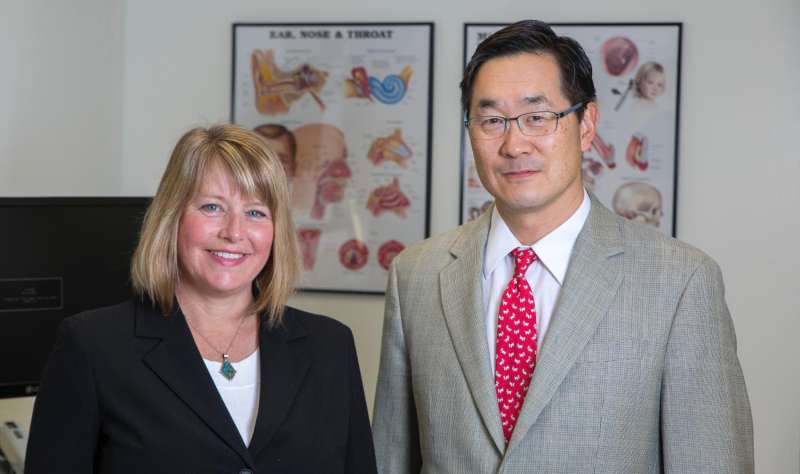Law aiding infants at risk for hearing loss

A Utah law has led to increased early identification of infants with hearing loss due to a congenital infection, according to a new study by University of Utah and Utah Department of Health researchers.
The study, published today in Pediatrics, is the first to assess how implementation of a state-wide screening can pick up hearing loss in infants due to congenital cytomegalovirus (CMV). Utah, which has the nation's highest birth rate, was the first state to mandate CMV screening for infants who fail newborn hearing tests. The Utah law is proving a model for other states.
"Our study demonstrates that policy changes such as the one in Utah that required CMV testing after failed newborn hearing screening can improve the identification of infants with hearing loss, even those without congenital CMV," said Marissa Diener, lead author and associate professor at the University of Utah's Department of Family and Consumer Studies. "This is important because timely identification of hearing loss can enable earlier intervention, which is linked to better language outcomes for children."
The Utah legislation also provided funds for educational campaigns surrounding congenital CMV, which is important given its prevalence, Diener said.
"Although congenital Zika infection is less prevalent in the U. S. than CMV, many people have heard of the Zika virus but fewer are familiar with cytomegalovirus," Diener said.
Cytomegalovirus is the most common congenital infection, affecting about 1 in 150 children or 30,000 newborns in the U.S. each year. In Utah that equates to roughly one baby born per day.
An infant born with the infection often shows no symptoms or signs; most of those infants do not experience any long-term effects. But the virus can potentially damage the brain, eyes and inner ear. It is estimated that 6 percent to 30 percent of hearing loss in children may be due to congenital CMV, making it the leading non-genetic cause of hearing loss in the United States.
In 2013, Utah became the first state to enact a public health initiative requiring CMV education and testing. The Utah Department of Health was tasked with creating a program about birth defects associated with and ways to prevent congenital CMV. (For more information about the program, please visit health.utah.gov/cmv.)
"CMV is transmitted through body fluids. Washing your hands often, especially after wiping a young child's nose, mouth or tears or changing diapers is important, said Stephanie Browning McVicar, co-author and director of the Cytomegalovirus Public Health Initiative at the Utah Department of Health. "What is also essential, though, is not sharing food, drink or utensils, particularly with young children, while pregnant."
The bill also requires all infants who fail two hearing screens to be tested for CMV within three weeks of birth unless a parent declines the test.
By using that time frame, health providers are able to distinguish between congenital CMV and CMV acquired after birth, which is rarely associated with health problems. The screening parameters also are designed to identify infants who do not have any symptoms but are most at risk for hearing loss.
The researchers used Utah Department of Health and Vital Records data to assess whether 509 asymptomatic infants who failed hearing tests between July 1, 2013 and June 30, 2015 underwent CMV screening and the results of that screening.
They found that 62 percent of these infants were tested for CMV and three-quarters were screened within the three-week time frame. Fourteen of those infants were CMV positive and six had hearing loss. Of the infants who were tested more than 21 days after birth, seven were CMV positive and three had hearing loss.
The researchers conclude that because these infants had no signs of infection, it is "highly likely" they would not have been diagnosed later as having congenitally acquired CMV. Identification of CMV-positive infants increased opportunities to watch their health more closely and intervene, when needed, more quickly. They also found more infants received timely diagnostic hearing tests after the law took effect.
"This result has major implications for all children who fail their newborn hearing screening since speech and language outcomes depend upon early hearing loss diagnosis," said Albert Park, co-author and chief of the U's pediatric otolaryngology division. "CMV infected infants with hearing loss may benefit from antiviral therapy. This question will hopefully be addressed in an upcoming NIH funded clinical trial that our group will be conducting to compare hearing, speech and language outcomes in CMV infected infants." The researchers suggest, based on their analysis of the data, that screening compliance could be increased by focusing educational and outreach efforts on certain groups who were less likely to get their infants screened for congenital CMV: less educated mothers, babies not born in a hospital and infants who received hearing tests later than 14 days after birth.
More information: Outcomes From a Hearing-Targeted Cytomegalovirus Screening Program, pediatrics.aappublications.org … 01/20/peds.2016-0789
















